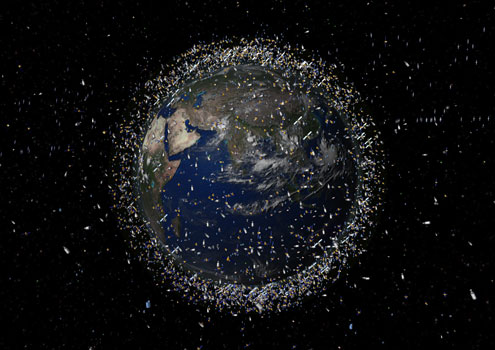The U.S. Air Force’s Space Fence program moved into its second phase last week when Lockheed Martin and Raytheon Company received contracts to develop a radar system to track orbital debris circling the earth. Orbital debris threatens the thousands of expensive and delicate satellites that enable communication, perform scientific research, and engage in military operations.
As TPM reported, the Space Fence project will be comprised of two to three radar stations placed throughout the world. Using the powerful radar arrays, the installations will help to automatically monitor the thousands of pieces of space debris that can travel as fast as 17,000 mph.
The Air Force expects the Space Fence will be operational by 2015 and will cost $3.5 billion.
The contracts awarded to Raytheon and Lockheed are each worth $107 million dollars and will last 18 months. During this period, the Air Force has tasked each company with figuring out exactly how the Space Fence will run and what technology and systems will be used. If all goes well, a prototype system could be produced by the end of the 18-month period.
Scott Spence, Program Director of Raytheon’s Space Fence Program described the next 18 months of work as “looking at what risk might still exist in meeting [the final design]. That risk can exist in the technology and/or in the schedule, and we will implement plans to drive that risk out of the program.”
Orbital trash has grown to be a pressing problem in the past few years. In November, CNN reported that the International Space Station had to adjust its course to avoid a collision. Orbital debris can be derelict spacecraft, intentionally released materials, solid rocket waste or even tiny flecks of paint that fall off of rockets.
But the ultimate answer to all the junk in floating in space is to physically remove it from orbit. Achieving that feat “is the sixty-four thousand dollar question,” NASA’s Chief Scientist for Orbital Debris Nicholas Johnson had told TPM. Japan’s national space agency thinks it might have an answer.
It has partnered with Nitto Seimo Company, a fishing net manufacturer, to develop a space net to drag down space debris with which it crossed paths. Eisuke Aizawa, a spokesman for Japan Aerospace Exploration Agency, told TPM that the idea is to attach electrodynamic tethers to a single piece of space trash. As the trash travels through space, it’ll both collect garbage and become charged by natural forces. This natural charge will drag the entire clump of debris into the atmosphere.
“The tether will collect electrons from the ambient plasma, making flow an electric current through the tether [and] generating a Lorentz force via interaction between the current and the geomagnetic field,” Aizawa explained.
“The concept is still at the research level,” though, Aizawa added.









